Durst F. Fluid Mechanics: An Introduction to the Theory of Fluid Flows
Подождите немного. Документ загружается.

21.1 Introductory Considerations 655
contamination occurs inherent for all components exposed to the fluid. Re-
liable measurements with hot-wire and hot-film anemometers are therefore
often possible only under laboratory conditions. In practical flow studies, one
accepts that dirt is deposited on the measuring sensors continuously with
time. The dirt layer developing on measuring sensors forms a heat insulation
that was not taken into account when the measuring sensor was calibrated.
In order to avoid measuring errors, caused in this way, recalibration of the
measuring probe has to be carried out at short time intervals, which can be
very time consuming.
Most measuring methods that require the insertion of measuring probes in
flows measure the flow velocity of interest only indirectly, i.e. with most flow-
measuring instruments physical quantities are measured which are functions
of the flow velocity. Direct measurements of the local flow velocity are often
not carried out. Unfortunately, the measured quantities, through which the
flow velocity is determined, are mostly also functions of the thermodynamic
state properties of the fluid medium. These fluid-property influences have to
be known and have to be taken into account in the calibration of the sensor,
in order to make the interpretation of the final measured data possible, i.e.
to yield the flow velocity through measurements. When fluctuations of the
state parameters of the fluid medium occur during measurements, e.g. in two-
phase flows, flows with chemical reactions, etc., these have to be known in
order to determine accurately the local velocity with hot-wire anemometers.
However, in practical measurements it is often not possible to know the fluid
properties at all measuring times, and they can therefore not be employed in
the interpretation of the measured velocity signals.
The above-mentioned difficulties in the employment of indirect measur-
ing techniques for flow velocities have led to the development of the laser
Doppler anemometry, which allows, almost directly, the local flow velocity
to be measured. By measuring the time which a particle needs for passing
through a well-defined interference pattern, the flow velocity of the parti-
cle is determined. Such measurements do not depend on the often unknown
properties of the flow fluid. Measurements are possible in one- and two-phase
flows, and also in combustion systems and in the atmosphere. The measuring
technique can moreover be employed in fluid media filled with particles, as
they often occur in practice. However, its employment requires optical access
to the measuring point and thus a sufficient transparency of the flow medium.
In this respect, the employment of laser Doppler anemometry is also limited.
Its application allows, nevertheless, the determination of flow velocities in a
number of flows that are important in practice, but cannot be investigated
by other measuring methods.
In addition to the above-mentioned measuring techniques for determining
local, time-resolved fluid velocities, the determination of pressure distribu-
tions is also very important in experimental fluid mechanics. This is given
consideration in the next section which treats the measurement of static pres-
sures. Introductory presentations of the measurement of dynamic pressures
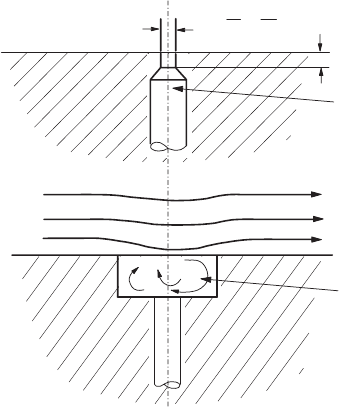
656 21 Introduction to Fluid-Flow Measurement
follow, in order to show that stagnation-pressure probes can be employed for
the determination of local velocities.
In addition to measurements of local velocities and pressures, measure-
ments of wall-shear stresses are often required in fluid-mechanical investiga-
tions. Although reference to measurements of these quantities occasionally
is made, they are not at the center of the considerations in this chapter.
The following considerations have rather to be understood as an introduc-
tion to flow-measuring techniques as a subfield of fluid measurements. The
introduced practice-oriented basics of flow and pressure measurements should
help to round off or complete the education of students in fluid mechanics.
21.2 Measurements of Static Pressures
In the discussion of flows with boundary-layer behavior (see Chap. 16), it
was shown that the momentum equation in the cross flow direction reduces
to ∂P/∂y = 0. This important property of the pressure field of boundary-
layer flows is often employed for the measurement of wall pressures, as it
permits one to determine easily the total pressure distribution in boundary-
layer flows without probes having to be inserted into the flow. In order to
determine now the pressure distribution P (x), with x being the flow direction,
it is sufficient to drill holes into the walls of the test rig, such as channels and
pipes, as shown in Fig. 21.2. However, for precise wall pressure measurements,
it is very important that the bore diameter is kept small, about the order of
Too large a hole
for wall pressure
measurements
≥
d
0.25 d 1.5 mm
<
<
Correct hole design
for wall pressure
measurements
Fig. 21.2 Measurements of wall pressures through holes in the walls
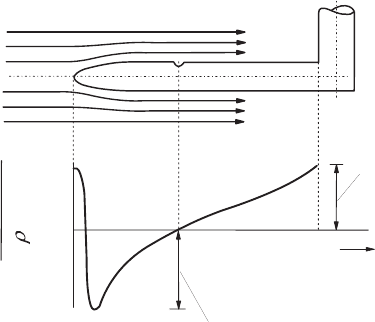
21.2 Measurements of Static Pressures 657
magnitude of 0.5 mm diameter. Too large bores lead to recirculation flows as
indicated in Fig. 21.2. These lead to measuring errors that yield wall pressures
that do not correspond to the true values. Similar errors can be caused by
disturbances introduced by burrs, edges, etc., that remain after drilling of
the pressure-measurement holes. Further information on making out pressure
holes can be found in [21.1] and [21.2].
A somewhat difficult task is the measurement of static pressures in flows,
where the pressure in the flow is not obtainable through wall-pressure mea-
surements as described above. In this case, probes have to be inserted into
the flow of the kind shown in Fig. 21.3. These static pressure-measuring
probes have a streamline design and are provided with one or more holes
in their walls. These holes are connected through pressure tubes of small di-
ameter, located in the interior of the probe, to pressure-measuring sensors
through which the desired pressure information is obtained. As indicated
in Fig. 21.3, it is very important that the appropriate location of the holes
is determined experimentally in such a way, that actually the local static
pressure is measured by the probe. Often, with sufficient precision, potential-
theory computations are suited to determine the best location for the holes
in the flow direction. The probe design shown in Fig. 21.4 proved valid for
the employment of static pressure measurements in flows.
In order to measure static pressures, it is necessary to employ cor-
responding pressure-measuring instruments. These are briefly described
below.
The simplest of these measuring instruments is the U-tube manometer
shown in Fig. 21.5. If a pressure difference develops between points A and B,
the liquid levels in the two tubes will adjust themselves in such a way, that
the existing pressure difference is compensated by gρ
F
h,withg being the
Pressure
too high
Influence of
probe holde
r
Position of
hole for static
pressure measurements
Influence of profile
Pressure
to o low
Streamlines
of the flow
1.0
0
P
stat,p
-P
stat,1
V /
1
2
2
1
Fig. 21.3 Measurements of wall pressures with pressure probes
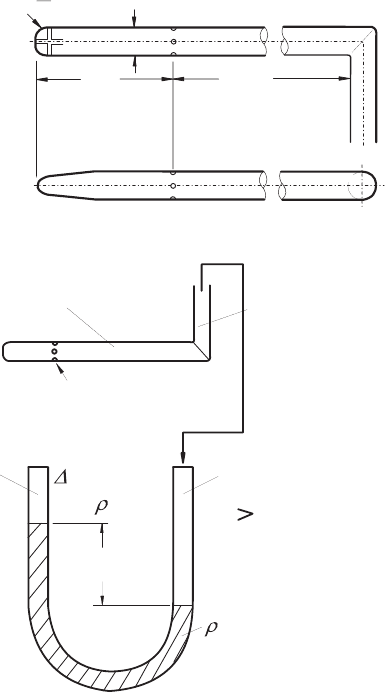
658 21 Introduction to Fluid-Flow Measurement
D
6 D
15 D
R
=
D
2
Suggested dimensions
Fig. 21.4 Pressure-measuring probe and location of static pressure-measuring hole
h
P
1
= P
0
P
2
P
2
P
1
F
P = P
2
- P
1
=
F
g h
Pressure measuring probe
P
2
P
0
= Atmospheric
pressure
h
= measure of the
pressure difference
A
B
=
Stat. pressure
P
2
Fig. 21.5 U-tube manometer for the measurement of pressure differences
gravitation constant, ρ
F
the density of the fluid in the U-tube and h the
difference in the height of the surface layers.
The distance between the layers of the two fluid levels h is therefore in di-
rect relation to the desired pressure difference and can be read by means of an
installed scale. It can easily be seen that the measurable pressure range of
the instrument can be adapted to each measuring problem by the selection of
different fluids (ρ
F
). The fluids most commonly used in practice are alcohol,
water and mercury, allowing h to be adapted to the measuring problems due
to the chosen fluid density.
When placing a large fluid reservoir at a location in the U-tube manome-
ter and inclining the actual measuring tube at an angle of (ρ
F
)towardsthe
horizontal line, as shown in Fig. 21.6, one obtains a considerable improve-
ment in the sensitivity of the manometer. A water column h develops, with
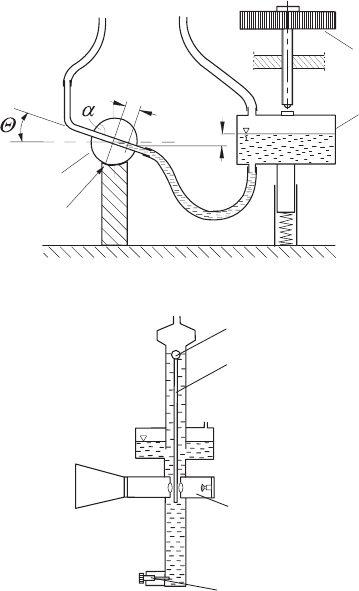
21.2 Measurements of Static Pressures 659
Micro-manometer
screw
Fluid
reservoir
x
∆
Microscope
Zero-marker
h
∆
Fig. 21.6 Inclined-tube manometer with zero adjustment
Floating element
Transparent
scale
Illuminated scale
and projection system
Zero level setting
Fig. 21.7 Betz manometer with optical reading system for low pressure difference
measurements
this set-up, i.e. a displacement of the fluid over a distance of h/sin θ in the
inclined arm of the instrument. The zero position, i.e. “zero adjustment” of
the instrument, is obtained by adjusting the height of the fluid reservoir.
In the Betz manometer, as shown in Fig. 21.7, a floating element with an
attached measuring scale is used to measure the change in the fluid level. The
scale, which is made of glass, is projected by an optical enlarging system on
to a screen, where another interpolation scale is installed. By this means the
reading precision of the measuring instrument is considerably improved.
In the employment of all manometers, a stable and vibration-free base is
of importance, in order to avoid vibrational influences on displays. Mobile
pipes between the pressure probe and the manometer employed have to be
avoided also, in order to avoid fluctuations of the fluid levels caused by pipe
movements, or by volume changes of the pipes. In particular, however, the
room temperature during a measurement has to be kept constant, as the den-
sity of the fluid (ρ
F
) is temperature-dependent, so that temperature changes
during the measurements are not measured as pressure changes in the flow.
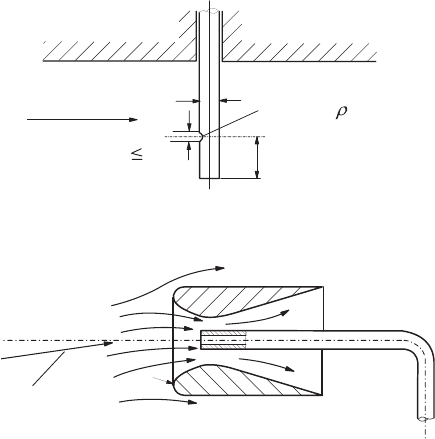
660 21 Introduction to Fluid-Flow Measurement
In today’s experimental fluid mechanics, the employment of U-tubes as
manometers is less common. Developments of pressure sensors have led
to measuring instruments that nowadays can be employed successfully to
measure pressures in fluid-flow experiments.
21.3 Measurements of Dynamic Pressures
In fluid mechanics, mechanical probes are employed for measuring the total
pressure P
∞
+(ρ/2)U
2
∞
. For these probes, different designs have been de-
veloped over the years. Particularly simple designs of total-pressure probes,
which are named Pitot probes, after the French physicist Henri Pitot (1695–
1771), are sketched in Fig. 21.8. Probes of this kind are very suited for
total-pressure measurements; however, they require precise adjustment, ori-
entating the probe in the flow direction, so that the angle influence of the
pressure distribution is eliminated. Only if this precaution is taken, one can
measure the desired total pressure correctly.
In some measurements, Pitot tubes of the kind sketched in Fig. 21.9 are
used that possess a nozzle around the actual Pitot tube. These probes are
less direction-sensitive. The nozzle serves a correcting device, guiding the fluid
flow, so that it passes the entrance of the Pitot tube in a more parallel way.
On combining a Pitot probe and a probe for measuring the static pressure,
one obtains the so-called Prandtl probe, that permits the following quantity
Flow direction
D
ca.
5D
0.2D
P = P +
/ 2 U
tot
2
oo
o
o
Fig. 21.8 Designs of Pitot probes to measure the total pressure P
tot
Flow direction
max. 45°
R
E
Fig. 21.9 Pitot probes mounted in a Venturi nozzle
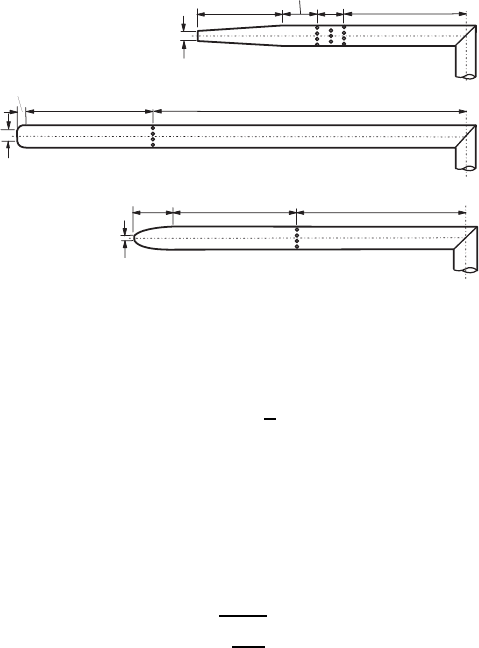
21.3 Measurements of Dynamic Pressures 661
D
/2 hole
0.052"
I.D
.
0.16"
I.D.
0.175"
O
.
D
.
1.3"
0.5"
0.4"
1.6"
15
D
6D
0.13"
0.6"
1.83"(5.9
D
)
2.52"(8.13
D
)
Fig. 21.10 Designs of Prandtl probes, shown with original dimensions, according to
data from the N.P.L. in England
to be found:
∆P = P
ges
− P =
ρ
2
U
2
∞
(21.1)
In Fig. 21.10, practical probe designs for Prandtl probes are shown. Prandtl
probes measure the total pressure at a corresponding probe tip and, through
the pressure holes placed downstream in the probe walls, the static pressure is
measured. Using pressure-measuring instruments to obtain the total pressure
and the static pressure at the same time, results in the displayed pressure
difference ∆P = P
tot
− P
stat
. This leads to the determination of the flow
velocity:
U
∞
=
$
2
∆P
ρ
(21.2)
Disregarding the perturbations introduced into a flow by the probe,
flow-velocity measurements with Prandtl probes can be categorized as un-
problematic when they are employed in laminar flows. Employment in
turbulent flows, on the other hand, is not free of problems. The reason for
this can be found in the continuous change of the flow direction and the con-
tinuous change in velocity magnitude which occur in turbulent flows. This
leads to integral pressure measurements which can only be interpreted with
difficulty, as far as the local mean velocity of the flows is concerned, as it ex-
its at the measuring location. It is important to emphasize that this problem
cannot be removed, even when using pressure-measuring instruments with
large time constants, despite the often held opinion in this respect. Due to
the hose connections from the probe to the measuring instrument, large time
constants already exist for most pressure measurements in fluid mechanics,
so that even the employment of fast pressure-measuring devices is not suited
to resolve the fast time-dependent pressure.
662 21 Introduction to Fluid-Flow Measurement
Hence, pressure probes are not suited to study turbulent flows. In this
respect, it is important to point out that the Prandtl tube measures the
dynamic pressure, but it is not suited to investigate the dynamics of turbulent
flow fields. Such investigations are better carried out with hot-wire and laser
Doppler anemometers.
When special measuring probes are employed, in spite of the above men-
tioned limitations, for investigations of turbulent velocity fluctuations, the
frequency characteristic of the probe has to be determined before the employ-
ment in turbulent flows fields. The probe has to be calibrated dynamically.
Such calibrations are difficult. Yet, efforts of this kind are undertaken again
and again in various research efforts in fluid mechanics. This indicates that
in spite of major problems with pressure-measuring probes, the measure-
ment of fast varying pressures is of importance in fluid mechanics. Because
of this, newly developed pressure sensors are employed, utilizing different
mechanisms to measure pressure and to convert the pressure into suitable
electronic signals. A pressure probe consists, in general, of the actual sensor
element having low mechanical inertia, a surface as large as possible and very
short transmission elements which connect the sensor to the location where
the electrical signal is recorded. Spring-plunger devices and also capacitive
and inductive transducers are employed in this respect. All these devices have
reached an advanced state of development and nowadays can be adapted to
support pressure measurements in fluid mechanics research.
21.4 Applications of Stagnation-Pressure Probes
In the preceding section, it was shown that stagnation pressure probes, in
connection with pressure-measuring instruments, can be employed in order
to measure velocities of flows. Stagnation probes are in principle open tubes,
one side of which is exposed to the arriving flow, while the other side is
connected to a pressure element. The pressure measured in this way is, in
principle, except for measurements at very low static pressures, proportional
to the mean force per unit surface of a fluid particle located in the stagnation
point of the flow. Measurement of the stagnation pressure and the static
pressure allow one to obtain the sought velocity information, if it is possible to
derive simple relationships between the velocity and the measured pressures.
This is in general possible only for non-viscous media. In viscous media, one
has to take the influence of the viscosity of the flowing fluid into account. This
was not taken into account when employing the simple evaluation equations
(see the equations in Sect. 21.2). In the following, it is shown how great the
influences of viscosity on measurement with pressure probes can be.
By appropriate analytical derivations, the total pressure (P
∞
+(ρ/2)U
2
∞
)
can be set in relation to certain properties of fluid flows, e.g. to the local flow
velocity and the locally existing static pressure. Corresponding analytical

21.4 Applications of Stagnation-Pressure Probes 663
considerations start, however, from assumptions that often do not exist in
experimental investigations. As an example, the measured pressure P
ges
is not
in agreement with the pressure that would be measured if one permitted the
locally existing flow velocity to stagnate in an isotropic manner, i.e. P
ges,i
=
P
ges
. Considerations taking geometric and dynamic influences into account,
allow one to express the pressure relation P
ges,i
/P
stat
, existing for real probes,
by multiplying the measured pressure by a correcting function. The latter
depends on the following parameters:
1. The Reynolds number of the flow, formed with the local flow velocity, the
kinematic viscosity of the fluid and the probe diameter, Re =(U
∞
D)/ν
2. The Mach number of the flow, Ma
3. The Prandtl number of the flow, Pr
4. The ratio of the heat capacitances, κ = c
p
/c
v
5. The intensity of the flow turbulence, k
2
/U
2
6. The Knudsen number, i.e. the ratio of the mean free path length of the
molecules to the probe radius as a characteristic quantity for a slip velocity,
λ/R
7. The ratio of the relaxation time of the molecules as an assembly to a
characteristic macroscopic time interval, t
m
/(R/U)
8. The angle of the inflow, i.e. the angle between inflow direction and probe
axis, α
In the subsequent paragraphs, some experimentally found dependencies of
the measured stagnation pressure on some of the above-mentioned influencing
quantities are given and discussed.
Provided that the Reynolds number Re =(UD)/ν is larger than approx-
imately 100, the above treated simple description of the flow around the
total-pressure measurements is sufficiently accurate, i.e. when treated by the
theory of ideal fluid flows. At smaller values of Re, however, the stagnation
pressure increases as a function of the Reynolds number and also depends on
the probe geometry. The measured total pressure can be expressed as
P
ges
= P +
ρ
2
U
2
∞
+2µβ (21.3)
From this pressure coefficient, C
p
results:
C
p
=
P
ges
− P
ρ
2
U
2
∞
=
2µβ
ρ
2
U
2
∞
(21.4)
The influence of viscosity on the pressure coefficient (C
p
)isshownin
Fig. 21.11, indicating the expected deviation at low Re-number.
When compressibility influences occur, the deviations between the
measured total pressure and the ideal value can be stated as follows:
P
ges
P
ges,i
=1+
M
2
∞
Re
3
2κC
1
!
1 − C
3
M
2
∞
"
1+
C
2
√
Re
4
1+
κ − 1
2
M
2
∞
−κ
κ−1
(21.5)
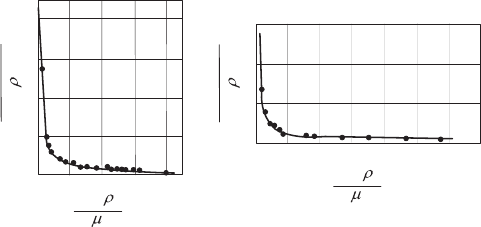
664 21 Introduction to Fluid-Flow Measurement
5
4
3
2
1
020
40
60
80
Re
oo
U R
=
020
40
60
80
4
3
2
1
100 120 140
Re
oo
U R
=
(Cylinder)
P
_
ges
P
ges, i
1/2
U
2
P
_
ges
P
ges, i
1/2
U
2
oo
oo
(Sphere)
Fig. 21.11 Viscosity influences on total-pressure measurements
All of the above explanations, relating to influences that exist for the practical
application of pressure probes, indicate that the application of stagnation-
pressure probes for flow investigations is linked to a multitude of practical
problems. Nevertheless, owing to the simplicity of application of pressure
probes in practical measurements and owing to their robustness, they are
still employed today in practical fluid mechanics.
21.5 Basics of Hot-Wire Anemometry
21.5.1 Measuring Principle and Physical Principles
Hot-wire anemometry is a measuring technique that permits electrical mea-
surement of local flow velocities, and it has been employed successfully for a
long time in experimental fluid mechanics and also in other fields. With hot-
wire and hot-film probes, local, rapidly changing fluid flows, requiring high
resolutions of measurements in terms of space and time, can be investigated.
Hot-wire and hot-film measurements are based on the measurement of the
release of heat from hot sensors to the medium flowing around them. Hot-
wire anemometry is therefore an indirect measurement technique, as it is not
the flow velocity which is measured, but the velocity-dependent heat release
from a thin, heated wire to the fluid medium surrounding it. In this respect,
the technique takes advantage of this velocity-dependent heat transfer of hot
wires and hot films for measuring the local flow velocity.
The heat release of the probe depends not only on the flow velocity,
however, but also on other quantities:
(a) The temperature difference between the sensor and the fluid medium
(b) The physical properties of the fluid medium and the sensors
(c) The dimensions of the sensors and the design of the hot-wire prongs
When keeping the influences (a), (b) and (c) constant, the sensor only
reacts to the flow velocity, and the heat, withdrawn from the sensor, is then
